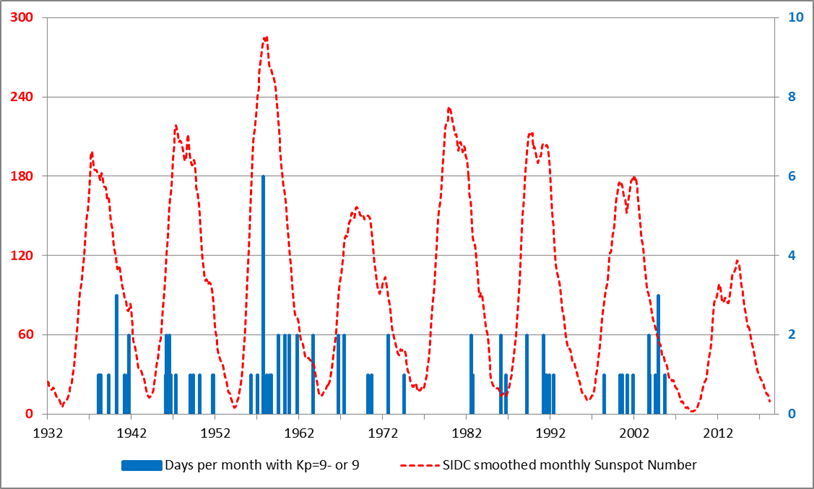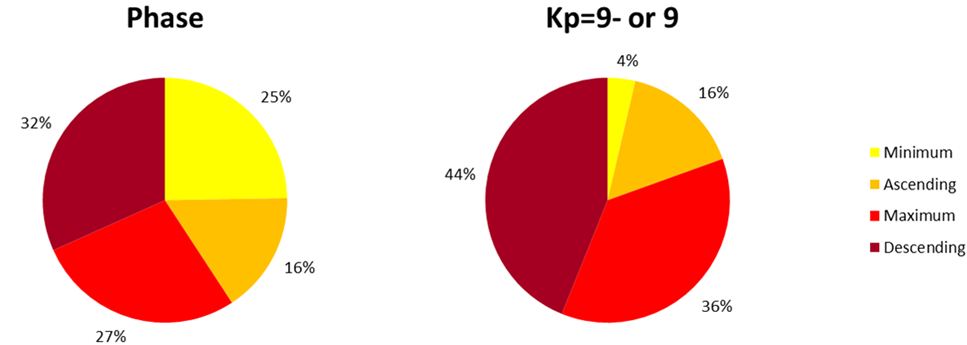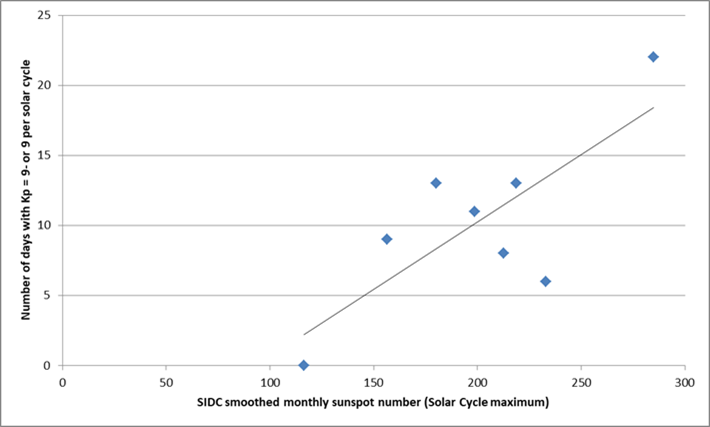As already pointed out in previous STCE Newsitems (e.g. here and here), the current solar cycle (SC24) is really weak in terms of geomagnetic activity. To illustrate this once more, we can make a comparison with previous cycles. To do this, the final Kp index (WDC Kyoto) was examined with data going back to 1932. Details on the Kp can also be found in this STCE Newsitem. For each day until 30 September 2018 (more than 85 years!), the maximum Kp was determined. The focus of this article is on the extremely severe geomagnetic storms, i.e. Kp = 9 (or G5 on the NOAA scales). However, as there have been only 26 such days, in this article also the days with a maximum Kp = 9- have been taken into account. Though technically Kp=9- belongs to the severe storming category (G4), these 56 additional days provide some much needed extra data points. For the rest of this article, all 82 days are labelled as extremely disturbed days, i.e. days with extremely severe geomagnetic activity.

In the graph above, the number of days with Kp=9 or 9- per month is shown and compared with the SIDC smoothed monthly international sunspot number (ISN, as provided by SILSO). There are exactly 0 (zero) such days for SC24. In fact, it's more than 13 years ago since the last Kp=9- day, and for the last Kp=9 day we have to go back to the good old Halloween period in October 2003. The period is obviously much longer than the previous record-holder, an 8-year interval from 1974-1982. Also, with the minimum still to come, the currently ongoing stretch does not seem to come to an end very soon. Noteworthy are also the 6 days near the maximum of SC19 (September 1957), and -despite the high sunspot numbers- the low number of days with extremely severe geomagnetic storming during SC21.

A solar cycle can be split in 4 phases, as shown in the graph above for SC23. The minimum phase can be defined as the period for which the smoothed ISN remains below 30, and during which the solar cycle minimum takes place. The maximum phase can be defined as the period when the smoothed ISN is above 80% of the solar cycle maximum. The ascending phase is then the interval during which the ISN rises, and the descending phase the interval during which the ISN decreases back to the cycle minimum phase.

The figure above (left) shows the percentage that each of these phases take in terms of the average solar cycle (average of cycles 17-24). The low percentage for the ascending phase and the high percentage for the descending phase reflect the asymmetry of the average solar cycle, which usually rises much more quickly to its maximum than that it decays back to the minimum. The number of Kp=9- or 9 days is not proportional to these percentages, as the figure above (right) shows. It's of course no surprise that there are almost no extremely disturbed days (not zero!) during the cycle's minimum phase, and that a large percentage occurs during the maximum phase. More interesting is that the largest percentage of extremely disturbed days occurs during the descending phase of the solar cycle. As Kp=9- or 9 days are basically caused by interplanetary coronal mass ejections (CMEs), this high percentage has nothing to do with the high speed wind streams related to coronal holes that are also most numerous during the declining phase of a solar cycle. It's already exceptional when coronal hole wind streams cause a strong (Kp=7 ; G3) geomagnetic storm.

Finally, one could ask if there's a relationship between the maximum smoothed sunspot number of a solar cycle, and the total of Kp=9- or 9 days that occur during that solar cycle. The graph above shows the result for the last 8 cycles (SC17-24), with SC24 the point at the lower left (no Kp=9- or 9 days), and SC19 in the upper right corner (22 such days). There seems to be some relation, but at the same time there's also quite some "noise". As a rule-of-thumb, one could take the maximum of the SC, divide it by 11, and subtract 9. Allowing for a healthy uncertainty margin of 5, this gives a good idea of what can be expected with respect to the number of extremely disturbed geomagnetic storming days. As an example, take SC17 which had a maximum of 198. The rule of thumb would indicate 9 +/-5 extremely disturbed days for this SC, very close to the observed 11 days.
There are at least two reasons for the rather large uncertainty. The first is that the ISN is only a measure for the number of sunspots, but does not say anything on the complexity of the sunspot regions. Such complex regions are a requirement for the production of solar eruptions that may be associated with strong earth-directed CMEs. The other reason is precisely that these complex active regions need to be located on the earth-facing solar hemisphere when they produce the eruptions. Indeed, things would have been quite different for SC24 if the famous, Carrington-like 23 July 2012 event had occurred just a week or two earlier!





